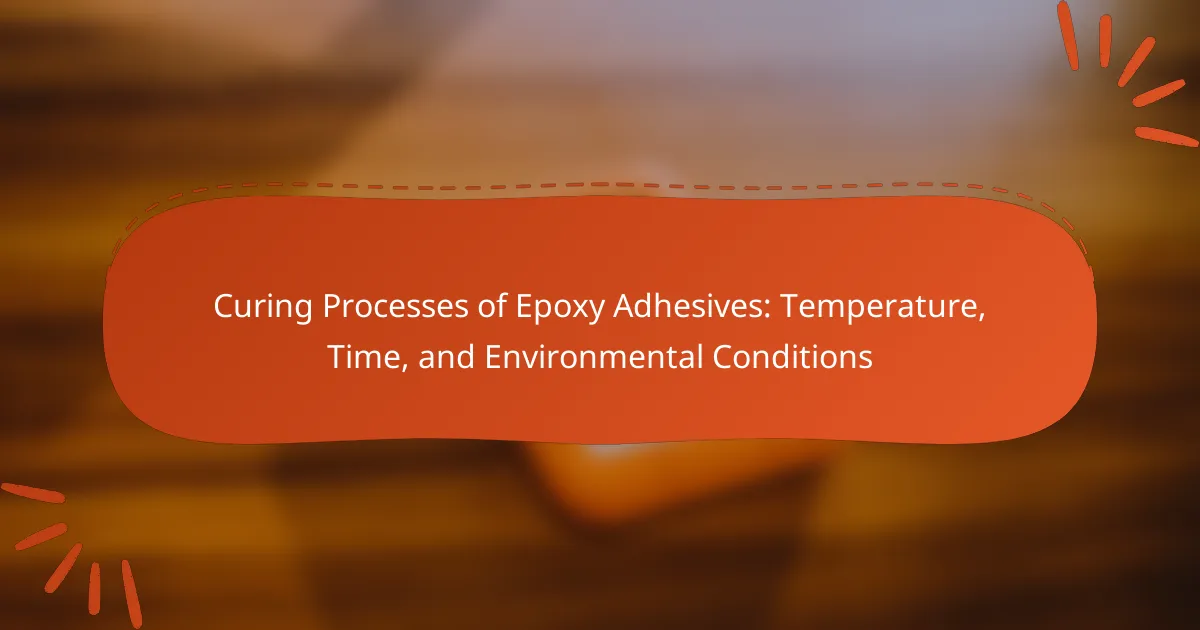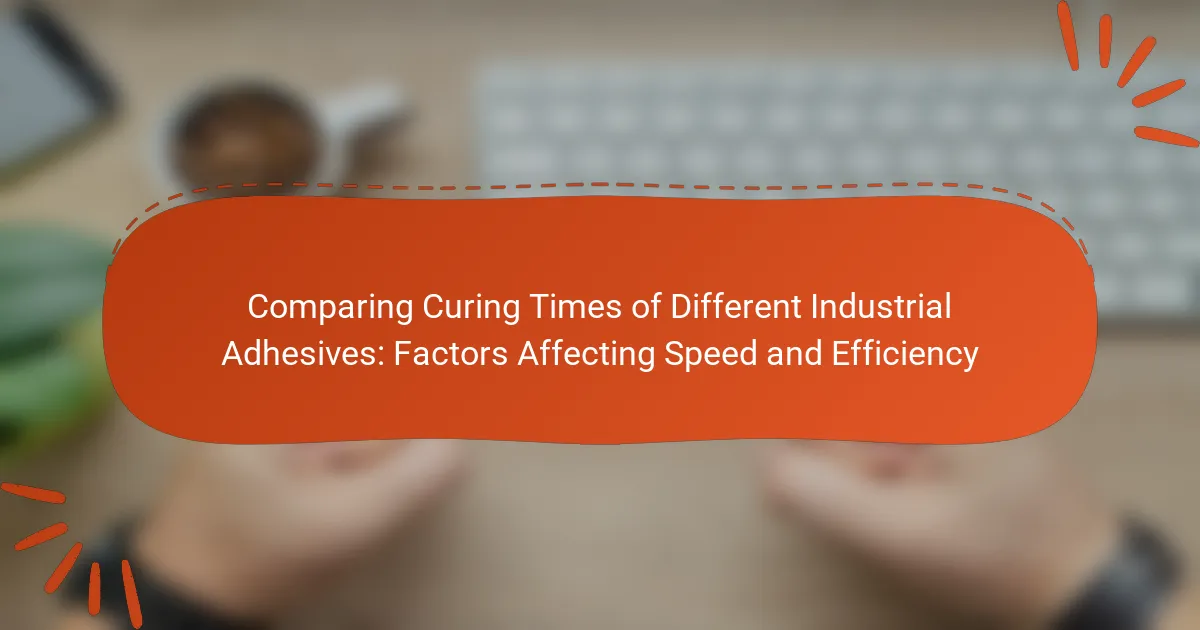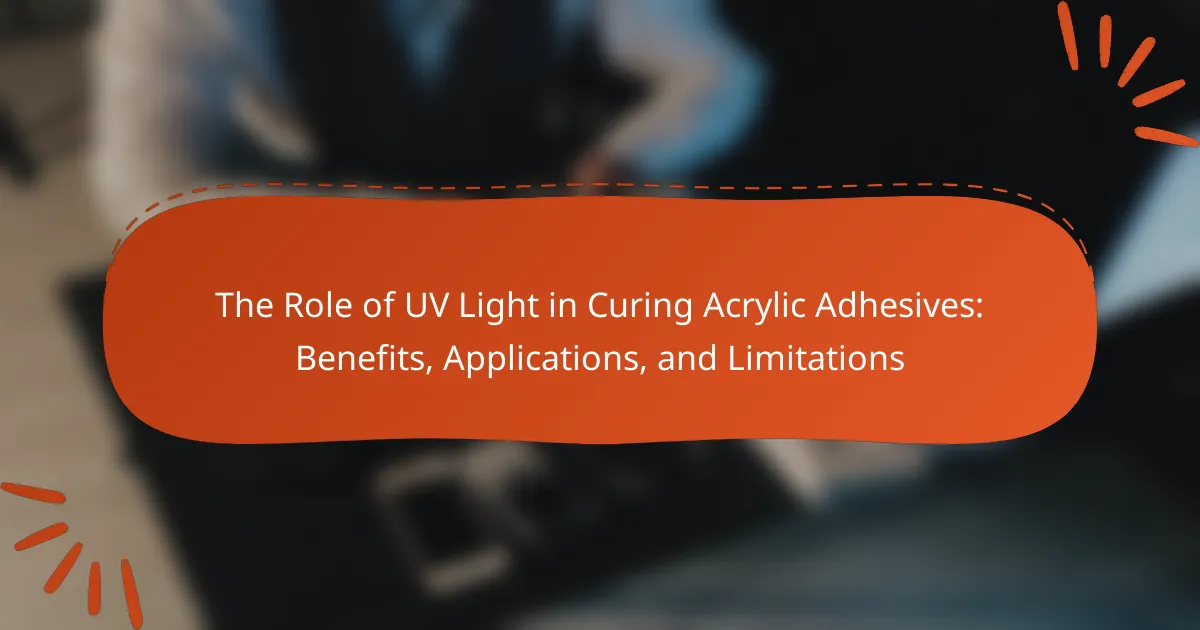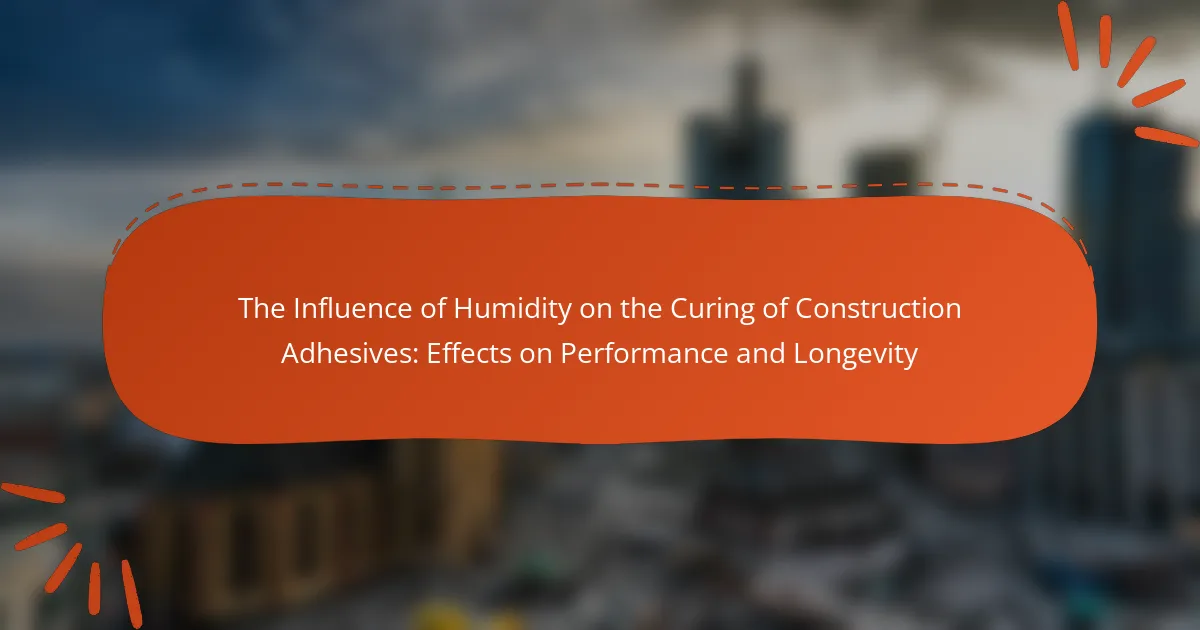Epoxy adhesives are specialized bonding agents that cure through chemical reactions initiated by hardeners. The curing process can be categorized into three methods: ambient temperature curing, heat curing, and accelerated curing, each influencing the adhesive’s final properties such as strength and durability. Curing typically occurs within a temperature range of 50°F (10°C) to 150°F (65°C), with environmental factors like humidity and airflow also playing significant roles in the efficiency of the curing process. Understanding the interplay of these variables is essential for achieving optimal performance in epoxy adhesives.
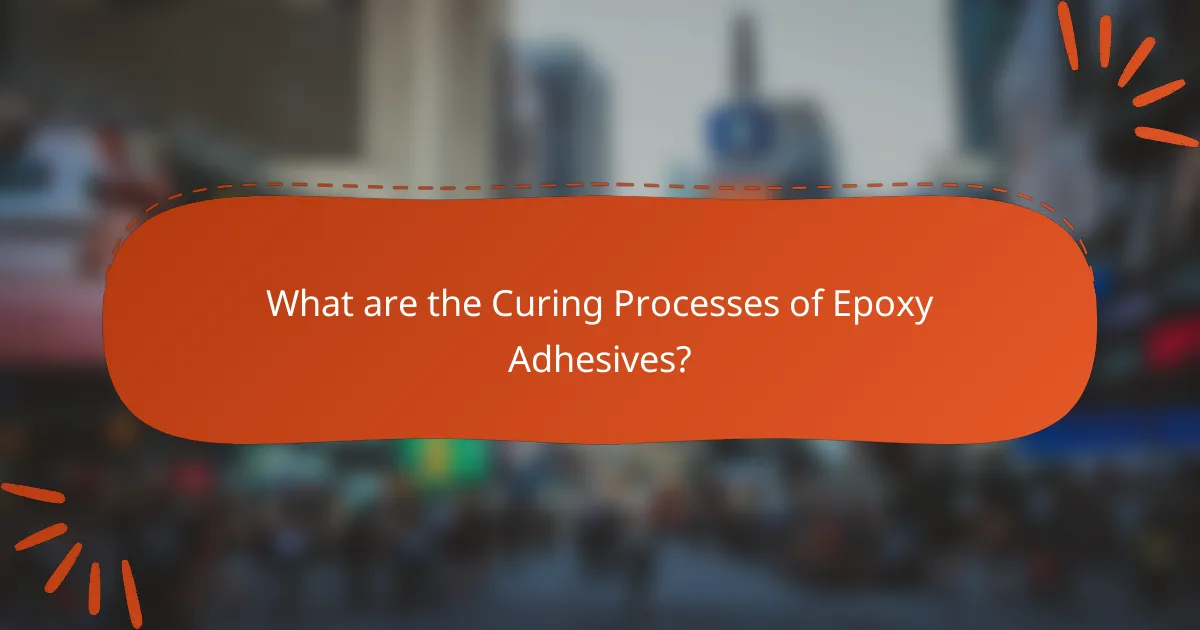
What are the Curing Processes of Epoxy Adhesives?
Epoxy adhesives cure through chemical reactions initiated by hardeners. The curing process can be classified into several methods: ambient temperature curing, heat curing, and accelerated curing. Ambient temperature curing occurs at room temperature and relies on the natural reaction between epoxy and hardener. Heat curing involves applying heat to speed up the reaction, enhancing bond strength. Accelerated curing uses additives or catalysts to promote faster curing times. Each method affects the final properties of the adhesive, such as strength and durability. Proper temperature, time, and environmental conditions are crucial for optimal curing. For instance, curing at higher temperatures can decrease the time required for full strength.
How do temperature, time, and environmental conditions influence curing?
Temperature, time, and environmental conditions significantly influence the curing of epoxy adhesives. Higher temperatures generally accelerate the curing process. For instance, curing can occur in hours at elevated temperatures, while lower temperatures may extend the curing time to days.
The recommended curing temperature range for many epoxy adhesives is between 20°C to 30°C. Outside this range, the chemical reactions involved in curing can slow down or become incomplete.
Time is also crucial; each epoxy formulation has a specific pot life and cure time. Extended exposure to the correct temperature can enhance the final properties of the adhesive.
Environmental conditions, such as humidity and airflow, can affect the curing process as well. High humidity can introduce moisture into the adhesive, potentially leading to defects. Proper ventilation ensures that solvents evaporate effectively during curing.
In summary, temperature, time, and environmental conditions are interrelated factors that dictate the efficiency and effectiveness of the curing process for epoxy adhesives.
What is the role of temperature in the curing process?
Temperature plays a critical role in the curing process of epoxy adhesives. It directly influences the rate of chemical reactions involved in curing. Higher temperatures generally accelerate the curing process, leading to faster hardening. Conversely, lower temperatures can slow down or even halt the curing reaction.
For instance, epoxy adhesives typically cure optimally within a temperature range of 20°C to 30°C. At temperatures below this range, the viscosity of the epoxy increases, which can impair the flow and bonding properties. Research indicates that every 10°C increase in temperature can double the reaction rate of curing.
This temperature sensitivity is crucial for achieving desired mechanical properties and adhesion strength in the final product. Therefore, maintaining the appropriate temperature is essential for effective curing and performance of epoxy adhesives.
How does time affect the curing of epoxy adhesives?
Time significantly affects the curing process of epoxy adhesives. The curing time determines the extent of cross-linking between epoxy resin and hardener. Longer curing times typically enhance the mechanical properties of the adhesive. This results in improved strength and durability of the bond.
In general, epoxy adhesives require specific time intervals to achieve optimal performance. For example, a standard epoxy may reach initial set within 30 minutes but requires 24 hours for full cure. Temperature can also influence the curing time; higher temperatures accelerate the curing process.
Research shows that epoxy adhesives cured at lower temperatures may take significantly longer to achieve full strength. According to studies, curing at room temperature can take up to 7 days for maximum performance. Therefore, understanding the relationship between time and curing is crucial for effective use of epoxy adhesives.
What environmental conditions are critical for effective curing?
Effective curing of epoxy adhesives requires specific environmental conditions. Optimal temperature ranges between 20°C to 25°C (68°F to 77°F) enhance the curing process. Humidity levels should be controlled, ideally below 70% to prevent moisture interference. Adequate ventilation is crucial to disperse any volatile organic compounds released during curing. Additionally, a clean surface free from contaminants promotes better adhesion and curing efficiency. These conditions ensure that the chemical reactions proceed as intended, leading to strong and durable bonds.
Why is understanding curing processes important?
Understanding curing processes is important because it directly affects the performance and durability of epoxy adhesives. Proper curing ensures optimal adhesion, mechanical strength, and chemical resistance. Epoxy adhesives require specific temperature and time conditions for effective curing. Deviations in these parameters can lead to incomplete curing and compromised bond integrity. Research shows that curing at the recommended temperature range enhances the adhesive’s final properties. Additionally, environmental conditions such as humidity can influence the curing process. Knowledge of these factors helps in selecting the right epoxy for specific applications.
How do curing processes impact the performance of epoxy adhesives?
Curing processes significantly impact the performance of epoxy adhesives. The curing process determines the final properties of the adhesive, including strength, durability, and chemical resistance. Temperature during curing affects the reaction rate of the epoxy resin. Higher temperatures typically accelerate curing, leading to stronger bonds. However, excessive heat can cause brittleness.
Curing time is also crucial; insufficient curing can result in incomplete cross-linking. This can lead to lower adhesion strength and reduced performance under stress. Environmental conditions, such as humidity, can influence curing as well. High humidity may cause issues with moisture absorption, affecting bond quality.
Research shows that optimal curing conditions enhance the mechanical properties of epoxy adhesives. For instance, a study by Zhang et al. in the Journal of Applied Polymer Science found that controlled curing conditions lead to improved tensile strength and thermal stability. Thus, proper management of curing processes is essential for maximizing the performance of epoxy adhesives.
What are the consequences of improper curing?
Improper curing of epoxy adhesives leads to several negative consequences. These include reduced adhesion strength, which compromises the bond’s integrity. Insufficient curing can result in a brittle finish, making the adhesive prone to cracking under stress. Additionally, improper curing may cause incomplete chemical reactions, leaving unreacted components that can affect performance. The final product may exhibit poor thermal and chemical resistance, making it unsuitable for demanding applications. Studies show that proper temperature and time are critical for optimal curing. For instance, a study published in the Journal of Applied Polymer Science indicates that curing below recommended temperatures can drastically reduce bond strength.
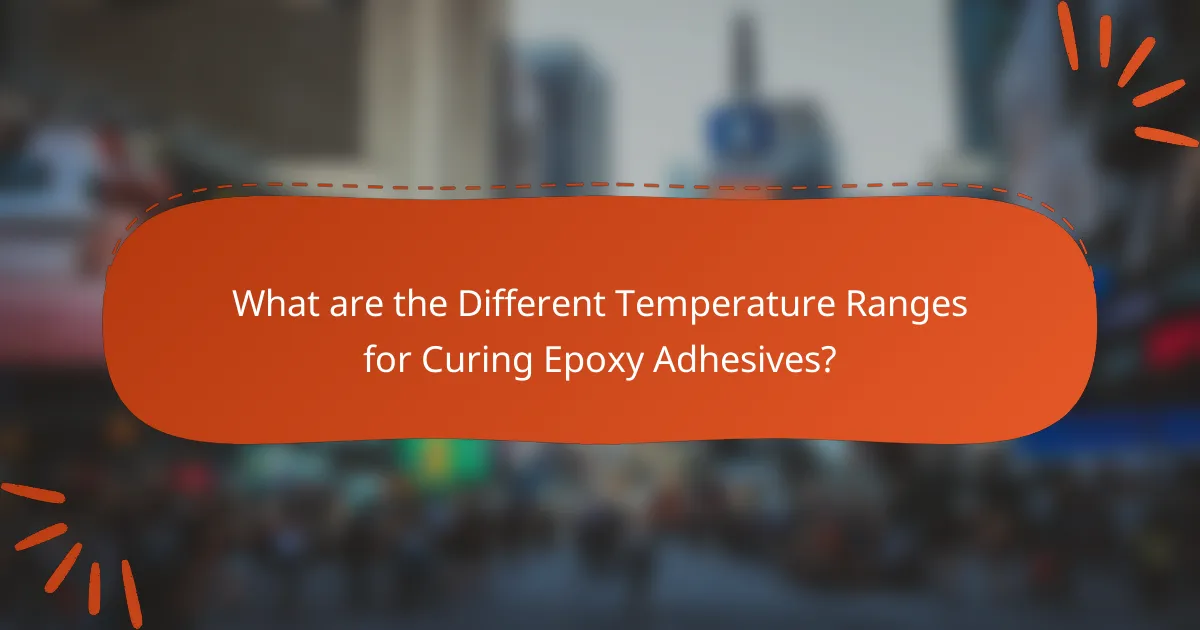
What are the Different Temperature Ranges for Curing Epoxy Adhesives?
Epoxy adhesives cure at different temperature ranges depending on their formulation. Typically, the curing temperature range is between 50°F (10°C) and 150°F (65°C). At lower temperatures, curing may take longer, while higher temperatures can accelerate the process. Some formulations are designed for ambient temperatures, while others require elevated temperatures for optimal performance. For instance, many standard epoxy adhesives cure effectively at room temperature, around 70°F (21°C). High-performance epoxies may require curing at temperatures up to 150°F (65°C) to achieve maximum strength. Temperature affects the chemical reaction rate, influencing the final properties of the cured adhesive.
How do varying temperatures affect the curing rate?
Varying temperatures significantly affect the curing rate of epoxy adhesives. Higher temperatures generally accelerate the curing process. For example, at elevated temperatures, the reaction between epoxy resin and hardener occurs more quickly. This can reduce the curing time from hours to minutes. Conversely, lower temperatures slow down the chemical reactions involved in curing. At reduced temperatures, the curing process can take several hours or even days. Research indicates that for every 10°C increase in temperature, the curing rate can double. This temperature dependency is crucial for optimizing curing conditions in practical applications.
What are the optimal temperature ranges for curing?
The optimal temperature ranges for curing epoxy adhesives are typically between 20°C to 30°C (68°F to 86°F). Curing at these temperatures promotes effective chemical reactions. Most epoxy formulations are designed to cure within this range for maximum performance. Some formulations may allow for lower temperatures, but this can extend curing time significantly. High temperatures, above 30°C (86°F), can accelerate curing but may also lead to issues like brittleness. Studies indicate that curing within the optimal range enhances bond strength and durability. Therefore, maintaining this temperature range is crucial for achieving the desired properties in epoxy adhesives.
What are the effects of low and high temperatures on curing?
Low temperatures slow down the curing process of epoxy adhesives. This results in extended curing times and may lead to incomplete curing. High temperatures accelerate the curing process, which can shorten the time needed for the adhesive to set. However, excessive heat can cause issues like increased brittleness and reduced bond strength. Research indicates that optimal curing temperatures typically range from 20°C to 30°C for most epoxy formulations. Deviating from this range can adversely affect the final properties of the cured adhesive.
What is the significance of time in the curing process?
Time is crucial in the curing process of epoxy adhesives. It directly affects the chemical reactions that lead to the hardening of the adhesive. Insufficient time can result in incomplete curing, leading to weak bonds. Conversely, excessive time can cause issues such as brittleness or degradation. The optimal curing time varies depending on the specific formulation of the epoxy and environmental conditions. Research indicates that most epoxy adhesives require a minimum curing time of 24 hours at room temperature for optimal performance. This timeframe allows for the necessary cross-linking of polymer chains, ensuring maximum strength and durability.
How does curing time vary with different epoxy formulations?
Curing time varies significantly with different epoxy formulations. Each formulation contains unique resin and hardener combinations that affect the curing duration. For instance, standard epoxy formulations may cure in 24 hours at room temperature. Fast-curing epoxies can set in as little as 5 to 10 minutes. Conversely, low-temperature or specialty formulations might require several days for full curing. The presence of additives, such as accelerators or retarders, also influences the curing time. Research shows that temperature increases can reduce curing time, with higher temperatures leading to faster chemical reactions. Therefore, the specific formulation and environmental conditions are crucial in determining the overall curing time of epoxy adhesives.
What are the indicators of a fully cured epoxy adhesive?
The indicators of a fully cured epoxy adhesive include hardness, clarity, and lack of stickiness. A fully cured epoxy will feel hard to the touch. It should also appear clear or slightly amber, depending on the formulation. Additionally, there should be no tackiness or residue on the surface. The adhesive will exhibit strong bonding strength upon full cure. Testing the bond strength can further confirm complete curing. Typically, full curing occurs within 24 to 72 hours, depending on the specific epoxy formulation and environmental conditions.
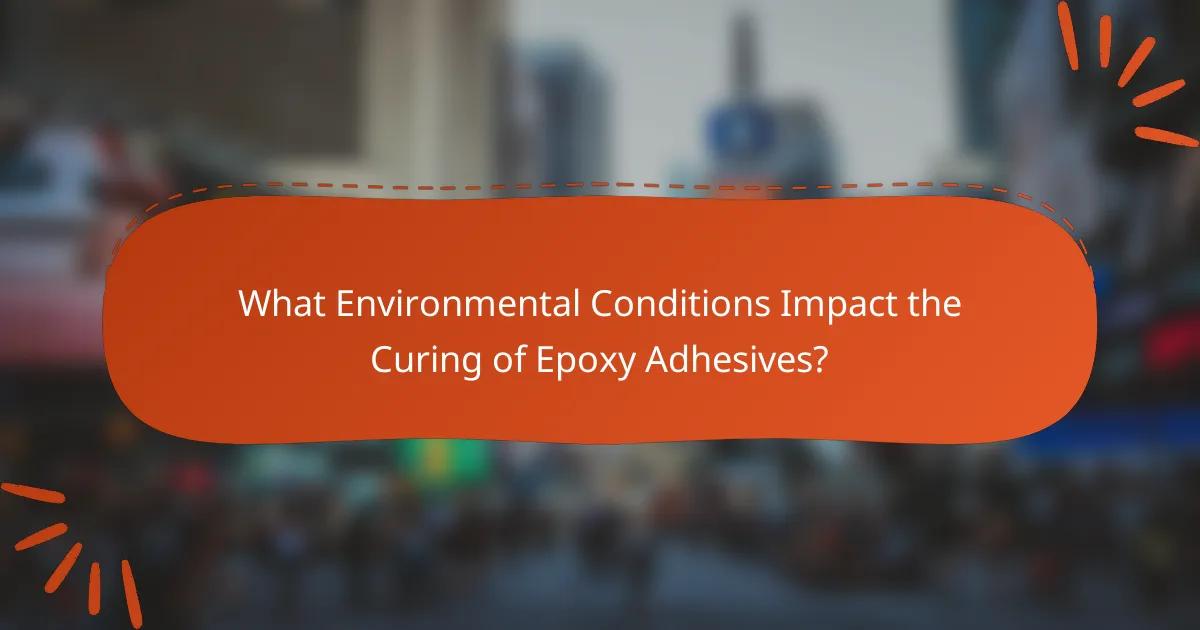
What Environmental Conditions Impact the Curing of Epoxy Adhesives?
Environmental conditions that impact the curing of epoxy adhesives include temperature, humidity, and airflow. Higher temperatures generally accelerate the curing process. For instance, curing at 25°C can be significantly faster than at 15°C. Humidity levels also play a crucial role; excessive moisture can hinder the curing process. Low humidity is preferable for optimal curing. Airflow affects the evaporation of solvents in some epoxy formulations. Adequate ventilation can enhance curing efficiency. Additionally, the presence of contaminants in the environment can lead to incomplete curing. These factors collectively influence the performance and final properties of the cured epoxy adhesive.
How does humidity affect the curing process?
Humidity significantly impacts the curing process of epoxy adhesives. High humidity can lead to slower curing times due to moisture interference with the chemical reactions. This moisture can also cause surface defects, such as blush, which can affect adhesion quality. Conversely, low humidity may accelerate curing but can lead to brittleness in the cured adhesive. Studies have shown that optimal humidity levels for curing epoxy range between 40% to 60%. Outside this range, the properties of the cured adhesive may be compromised.
What precautions should be taken in high humidity environments?
In high humidity environments, it is crucial to control moisture levels to ensure optimal curing of epoxy adhesives. Excess humidity can lead to improper bonding and reduced adhesive strength. Use dehumidifiers to maintain humidity levels between 40% and 60%. This range is ideal for curing epoxy effectively. Ensure proper ventilation to facilitate air circulation. Avoid applying epoxy during peak humidity times, typically early morning or late afternoon. Monitor temperature closely, as high humidity can affect the curing temperature. Use moisture-resistant epoxy formulations when necessary. Proper surface preparation is essential to remove any moisture before application. Following these precautions will enhance the performance of epoxy adhesives in humid conditions.
How does airflow influence curing effectiveness?
Airflow significantly influences curing effectiveness by promoting the evaporation of solvents and enhancing heat dissipation. Proper airflow helps maintain optimal temperature conditions during the curing process. Increased airflow can prevent overheating, which may lead to uneven curing or degradation of epoxy properties. Studies show that adequate ventilation can improve the overall mechanical properties of cured epoxy. For instance, a controlled airflow environment can lead to a more uniform cross-linking of the epoxy resin. This results in stronger adhesion and durability. Inadequate airflow can cause issues like trapped moisture, leading to defects in the cured adhesive. Therefore, airflow is crucial for achieving desired curing outcomes.
What best practices should be followed for optimal curing?
Optimal curing of epoxy adhesives requires maintaining specific temperature and humidity levels. The ideal temperature range for curing is typically between 60°F to 90°F. Higher temperatures can accelerate curing but may compromise bond strength. Conversely, lower temperatures can slow the process, leading to incomplete curing.
Humidity should be kept low, ideally below 70%, to prevent moisture interference. Mixing ratios of resin and hardener must be accurate, as incorrect ratios can lead to weak bonds.
Curing time should align with manufacturer recommendations, often ranging from several hours to days, depending on the formulation. Proper ventilation is essential to dissipate any fumes and ensure a safe working environment.
Using clamps or weights can help maintain pressure during the curing process, enhancing adhesion. Regular monitoring of environmental conditions can also ensure optimal curing outcomes.
How can one ensure the ideal curing conditions are met?
To ensure the ideal curing conditions for epoxy adhesives, maintain a consistent temperature within the recommended range. Epoxy adhesives typically cure best between 60°F and 90°F. Monitor humidity levels, as high humidity can affect the curing process. Ensure proper ventilation to facilitate the release of any volatile organic compounds. Follow the manufacturer’s guidelines regarding mixing ratios and application thickness. Use a thermometer and hygrometer to track environmental conditions accurately. Conduct a test cure on a small sample if uncertain about the conditions. These steps help achieve optimal adhesion and performance.
What common troubleshooting tips exist for curing issues?
Common troubleshooting tips for curing issues with epoxy adhesives include ensuring proper mixing ratios. Incorrect ratios can lead to incomplete curing. Maintaining the correct temperature is essential; epoxy typically cures best between 60°F and 90°F. High humidity can also affect curing; a dry environment is preferable. Inspect the surface preparation; contaminants can hinder adhesion and curing. Allow adequate curing time; most epoxy adhesives require at least 24 hours to fully cure. If issues persist, consider using a different epoxy formula tailored for specific conditions. These strategies help ensure optimal curing performance.
The main entity of this article is epoxy adhesives, specifically focusing on their curing processes. The article outlines how curing methods, including ambient temperature, heat, and accelerated curing, affect the adhesive’s final properties such as strength and durability. It emphasizes the critical roles of temperature, time, and environmental conditions like humidity and airflow in optimizing the curing process. The article also discusses the consequences of improper curing and provides best practices for achieving ideal curing conditions, ensuring maximum performance and reliability of epoxy adhesives.
